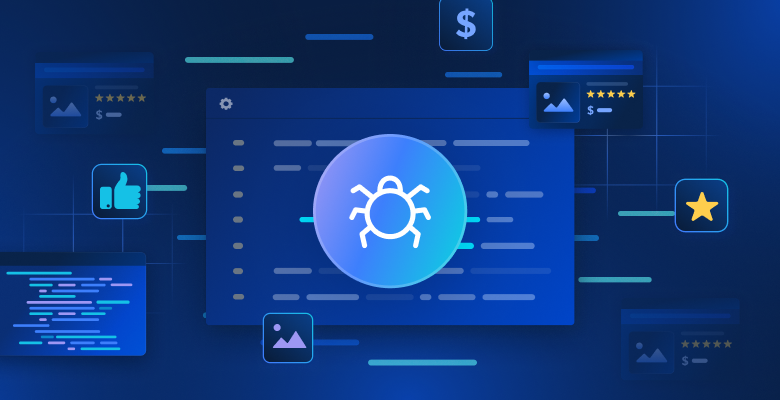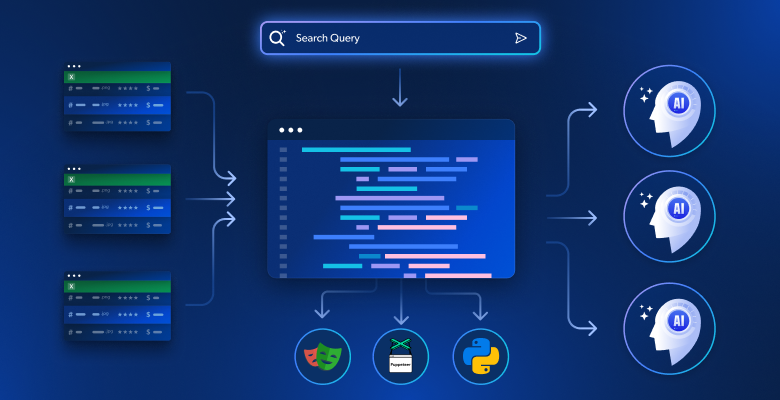In this article we will discuss the following questions:
- What is the difference between a proxy network and a VPN?
- What is a proxy network and how does it function?
- How are proxy networks used for data collection?
- What happens if I do data collection without a proxy network?
- What can I use a proxy network for besides data collection?
- When was the first proxy network created?
- How can I use proxy networks to expand my business?
What is the difference between a proxy network and a VPN?
To be fair, VPNs, and proxy servers have their share of similarities. They both enable third-party mediated access to another website. The main difference is that proxies mainly function in a way that redirects your web requests which can help you accomplish load balancing, sending multiple simultaneous requests, as well as appearing as an individual user. VPNs on the other hand are used mainly for anonymizing your network traffic completely, and/or changing your geolocation.
It would also be fair to say that proxies are more for a business data collection or monitoring tool, whereas VPNs are for the most part used for individual consumers. A typical VPN user may be a Mexican national working and living in the US but wanting to access Spanish-language content. He or she would then use a VPN to appear as if they are located in Mexico City despite being in Dallas and then be able to freely stream their target content.
On the other hand, a Mexican fabrics producer may utilize a proxy network in order to collect data points on competing American firms in terms of pricing, production, and distribution lines. By using real peer IPs located in the US, they are almost guaranteed to retrieve more accurate datasets than if they were routing requests through their Mexico-based IP.
What is a proxy network and how does it function?
In a regular scenario, you access a website directly using your IP address. Once the site is reached, you are served information that very often is tailored based on your geolocation and other parameters.
When using a proxy, however, you send your ‘request’ to the proxy server, and then they route that through an IP address to your target site. The requested data is then sent back, downloaded, and delivered back to your destination of choice.
This option can be beneficial to you if you want to:
- Maintain anonymity
- View content, pricing, ads, and other content from a local user perspective
- Ensure that datasets are accurate and not biased against high volumes of requests originating from the same IP address
How are proxy networks used for data collection?
Proxy networks are used for data collection in a variety of ways, namely:
- Price comparison – Proxy networks enable businesses to route traffic through localized peer IPs meaning they can view flight prices being displayed by competitors to a consumer located in NYC. As this is a real person, prices are likely to be more accurate, enabling them to better compete.
- Brand protection – Companies who are worried about unauthorized third-party retailers selling their goods or diluting their brand through faulty advertising, use proxy networks to identify such malicious activities. Once identified, their legal teams are able to take targeted actions against the offending parties.
- Competitive intelligence – When operating in the context of an industry, corporate entities want to know what their competitors are up to without them knowing or distorting publicly available data. Proxies enable companies to collect data such as the number of downloads of a new app or product reviews.
- Ad verification – Huge sums of money are invested in digital marketing campaigns on an annual basis. But the sad truth is that large swaths of marketing budgets get wasted on ads that are never served to their target audience or have some portion inadvertently distorted. Using a proxy network, companies can view the web from the perspective of an Argentinian consumer, for example, and verify that the copy, visuals, and language are all spot-on.
- Search engine monitoring – Proxy networks enable businesses to see which keywords are trending in a specific market, what a specific target audiences’ search results pages are showing, and what branded or unbranded content has the highest Click-through rates (CTRs).
What happens if I do data collection without a proxy network?
Data collection can be performed without a proxy but on a very limited basis. The reason for this is that you are most likely using one IP address or even a handful of IP addresses. When you are running a business of any size and are looking to collect data to be more competitive and in line with current consumer trends, the required volumes of data increases. When you start sending anywhere from tens of requests to hundreds or even thousands of requests for data from the same IP or group of IPs, that is when you start running into trouble. Typically target sites will mark your IPs as displaying problematic, and then either block you or purposely serve you inaccurate information.
What can I use a proxy network for besides data collection?
There is a common misconception that proxy networks only serve businesses for data collection. While this is a major use case, it is a real misconception. Proxy networks can be used for other purposes (including but not limited to):
- Web monitoring – For example companies utilize proxy networks in order to monitor for unauthorized brand mentions, third-party piracy retailing, and intellectual property infringements
- Ad verification – For example, ensuring that the copy, images, and language are being served as originally designated to target audiences in specific geolocations
- App user experience (UX) verification and quality assurance (QA) – For example, routing traffic through a real-peer user device in order to see how a target audience is experiencing a specific app in a certain GEO, and ensuring that the UX is smooth.
Are there cost-efficient proxy options?
Yes, some people and businesses sometimes think that using a proxy network is in fact a very expensive endeavor, and the truth is it can be. But it does not have to be. First and foremost it depends on which type of proxy network you choose to use. In our ‘Ultimate guide to proxies’, for example, we show that our Mobile Proxy Network is indeed the most expensive option, yet it is also the most effective one especially for companies operating in ‘stealth mode’.
On the other end of the spectrum is the Data Center Network which is the most cost-effective proxy option intended for easy to reach target sites.
Other cost-efficient options that Bright Data offers customers include:
- P-A-Y-G: Pay-As-You-Go is a great option for companies that do not want to commit in advance to a certain data collection volume. This option can start as cheap as $0.90 per IP, plus $0.12 per GB.
- Experimenting pricing plans: We offer monthly plans that start at as little as $300 per month for companies that want to start experimenting with some of their ideas without breaking the bank.
When was the first proxy network created?
UC Berkeley laid claim to the first ‘transformational proxy’. In 1997 university researchers were fed up with slow internet connections through the then-popular phone/dial-up connections. The new approach called ‘TranSend’ enabled users to retrieve pages/data 3-5 times faster than the traditional method. There was also a ‘shared cache’ of popular pages that could be accessed immediately with zero waiting time. Instead of bogging servers down with various versions of web pages for people with different internet speeds, TranSend collected existing page versions allowing each user to determine if they prefer higher quality and slower loading speed or vice-versa.
How can I use proxy networks to expand my business?
Proxy networks can be used to expand your business in the following ways:
- Competitive intelligence – This means you can collect information on your competitors, and make better strategic decisions in accordance. For example, you can collect pricing, bundle, and advertising data to help inform your own business decisions.
- Identifying current consumer trends – By monitoring search engine trends, popular industry keywords, and social media sentiment you can identify and latch onto current consumer trends. This can inform your marketing campaigns, production lines, and even where you choose to warehouse your goods based on consumer base geolocation.
The bottom line
There are many proxy network misconceptions. Hopefully, this guide was able to help demystify some of them for you, enabling you to understand what a proxy really is and what value it can bring to the table for your business.







